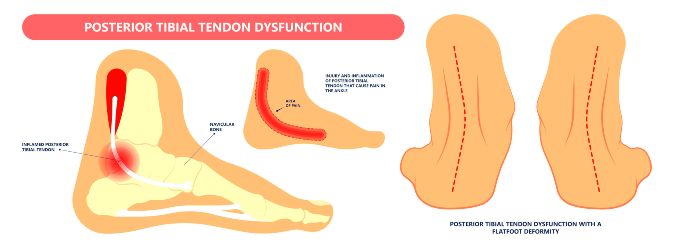
Tibialis Posterior Dysfunction Treatment at Phoenix Podiatry
At Phoenix Podiatry, we specialize in the diagnosis and treatment of tibialis posterior dysfunction, a condition that affects the tibialis posterior tendon located on the inside of the ankle and foot. This tendon plays a crucial role in maintaining the arch of the foot and providing stability during walking and running. When the tendon becomes inflamed or damaged, it can lead to pain, instability, and other foot-related problems. Our skilled podiatrists are dedicated to helping you find relief and improve your foot function.
Understanding Tibialis Posterior Dysfunction:
Tibialis posterior dysfunction is a progressive condition that typically occurs due to overuse, biomechanical imbalances, or injury. The tibialis posterior tendon can become weakened or inflamed, leading to symptoms such as:
Pain and swelling on the inside of the ankle or foot
Difficulty walking or running, especially on uneven surfaces
Flatfoot deformity or a noticeable collapse of the arch
A feeling of weakness or instability in the foot and ankle
Limited range of motion in the affected foot
Treatment Options for Tibialis Posterior Dysfunction:
Conservative Treatments: In the early stages of tibialis posterior dysfunction, conservative treatments are often effective in managing symptoms and preventing further progression. These treatments may include:
Rest and Immobilization: Taking a break from activities that aggravate the tendon and using supportive devices such as a walking boot or brace to protect the foot and allow healing.
Physical Therapy: Our podiatrists may recommend specific exercises and stretches to strengthen the muscles supporting the foot, improve stability, and restore normal foot mechanics.
Custom Orthotics: We provide custom-made orthotic devices to support the arch, reduce stress on the tibialis posterior tendon, and improve foot alignment during walking and running.
Footwear Modifications: Our podiatrists can suggest appropriate footwear with good arch support and stability to alleviate symptoms and promote proper foot function.
Advanced Treatment Options: In cases where conservative treatments do not provide sufficient relief, or if the condition has progressed significantly, our podiatrists may recommend more advanced treatment options, including:
Laser Therapy (LLLT): Low-Level Laser Therapy can help reduce inflammation, promote healing, and provide pain relief in the affected area.
Non-Surgical Interventions: In some cases, corticosteroid injections or other forms of targeted medication delivery may be used to reduce inflammation and alleviate symptoms.
Surgical Intervention: Surgery may be considered for severe cases or when conservative treatments have not been effective. Our podiatrists will discuss surgical options, if necessary, and guide you through the process.
Our podiatrists will conduct a thorough evaluation to assess the severity of your tibialis posterior dysfunction and develop a personalized treatment plan based on your specific needs and goals. We strive to provide comprehensive care, aiming to reduce pain, improve foot function, and enhance your overall quality of life.
To seek expert care for your tibialis posterior dysfunction, please contact us at 9434 2006 to schedule an appointment or conveniently BOOK ONLINE now. Our dedicated team is here to provide effective treatment options and compassionate care to help you find relief and regain your foot function.
